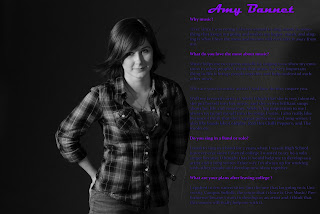Interview
Name: Amy Bennet
Age: 18
Student at Suffolk New College
Singer: Indie, pop, r&b and rock
Born: Ipswich , Suffolk
Why music?
-Ever since I was young I always wanted to sing, music is something that keeps me going and makes me happy, music and singing is what I love the most and no one will ever take it away from me.
What do you love the most about music?
Music helps me to express myself, by singing i can show my emotions to other people. I think that music is a very important thing in life it brings people together and help understad each other more.
Who are your favourite artists? And how do they inspire you.
Well my favourite artist is Adele I think that she is very talented, she put herself into her music, and she writes brilliant songs about her life and emotions. Adele is big inspiration to me I always try to put myself into the songs I write. I also really like Beyonce I think that she’s a great performer and song writer. I also like bands like Coldplay, Red Hot Chilli Peppers, and The Kooks etc.
Do you sing in a Band or solo?
I used to sing in a band for 2 years when I was in High School however ever since I started college I wanted to try be a solo singer because I thought that it would help me to develop as a artist and a song writer. Ether way I’m always up for working with other people and develop new ideas together.
What are your plans after leaving college ?
I applied to few universities, but the one that Im going to is University Campus Suffolk, the coure that i choce is Live Music/ Preformence becaue i want to develop as an artist and i think that this coures will really help me with it.
Where do you see yourself in ten years time?
Its hard to say, i hope i will bocome a singers or a song writer and hopefully move to London so i can develop my careea as there is more oportunities in music industry. Becoming a famous singere and song writer is my dream and i will take any chance i get to get where i want to be in the future.
Some ideas for final layout:
Evaluation
Before I planned the photo shot I did an interview with Amy to find out more information about her and to get to know her more.
Shooting process went well, however it was a little bit awkward at the beginning because Amy felt a little bit uncomfortable and didn’t want to look into the camera or pose differently, however once we got started she felt more comfortable and the shooting went well. I took some photos of Amy standing facing different direction, took some photos of Amy posing with her microphone because it gave a really cool edgy look as she’s a vocalist and it made the shadow look more interesting, I also took some photos of Amy sitting down.
After doing a bit of research about shooting musicians I thought of an idea with a dark shadow of Amy in the background, I thought that it would make the photos look different and more interesting, it would also suit Amy’s gothic/punk style but at the same time it would make her look very natural and feminine.
Lighting looked really good contrasting with Amy’s skin tones and the dark background. I think that it all worked well together and met Amy’s expectations of this photo shot
I think that the background and the colours and also what Amy was wearing gave the whole shot kind of Gothic dark look. I really liked the shadow effect on the background however I had to make it a little bit darker by using the Photoshop to make it stand out more. I did few sample ideas for the final layout by changing the colours around and playing around with different fonts.
Amy was really pleased with all the final photos, she really liked the colours and the shadow effect, however if I did this photo shoot again I would suggest to use a lighter background, I also think that studio photos have really limited what I could of done by using the Photoshop, those photos didn't really need any specific corrections or any fancy changes. This task gave me a lot of knowledge about shooting a musician’s or any band. This task also helped me to develop my photography skills using the camera as well as the lighting set up and the studio set up.
































